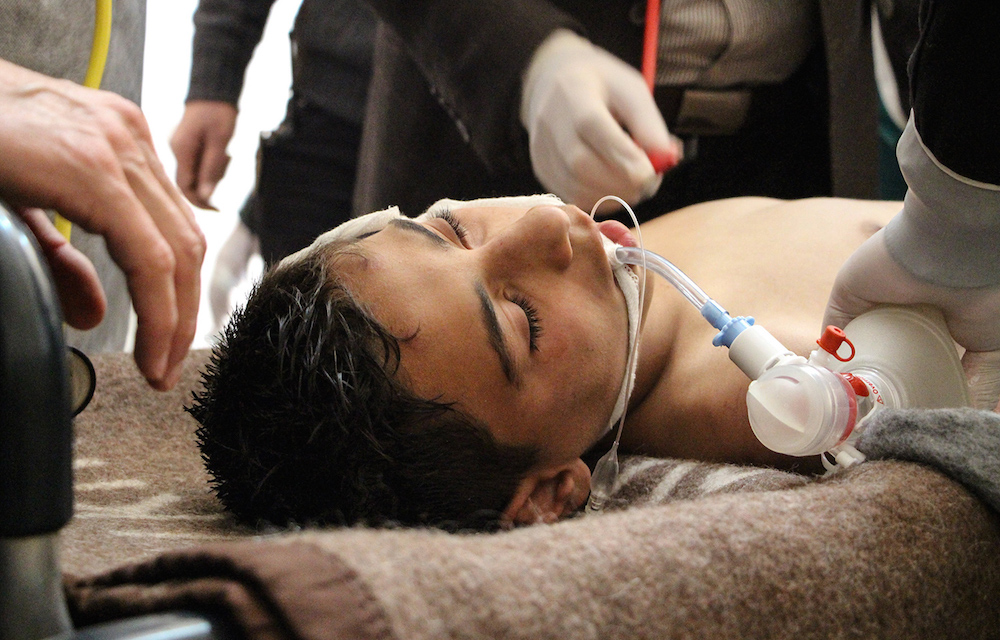Chemical Attack in Syria: What's the Science Behind Nerve Agents?
Another recent, high-profile death was also due to a nerve agent — VX nerve agent was used to kill Kim Jong-nam, the half brother of North Korean leader Kim Jong-un, in February. But what exactly are these deadly chemicals, and what sort of treatments can save those who have been exposed?
Nerve agents are highly poisonous chemicals that can interfere with the nervous system's signaling, according to the Centers for Disease Control and Prevention (CDC). There are several types, but the most well-known nerve agent is probably sarin, which first gained widespread recognition after the doomsday cult Aum Shinrikyo used it during the Tokyo subway attacks in 1995, killing 12 people. [5 Lethal Chemical Warfare Agents]
In a more recent sarin attack, the Syrian government deployed the gas in the suburbs of Damascus in 2013, killing more than 1,000 people, according to The New York Times. After that attack, Syrian President Bashar al-Assad said he would forfeit Syria's chemical weapons and demolish chemical production and storage facilities in the country.
Other nerve agents include soman and tabun, which are clear, colorless, tasteless liquids that have a slightly fruity smell, according to the CDC. Both can become vapors when heated.
Sarin, soman and tabun are all based on insecticides that were developed in the 1930s and 1940s. These pesticides, as well as nerve agents, belong to a class of chemicals called organophosphates. The nerve agents and insecticides work in similar ways but affect the body in different places, although there is some overlap in symptoms, said Dr. Lewis Nelson, the chairman of emergency medicine at Rutgers New Jersey Medical School.

How they work
Organophosphate pesticides and nerve agents both bind to an enzyme that turns off the nerve-signaling molecule acetylcholine. Without the enzyme to turn it off, acetylcholine will continue to "aggressively" stimulate certain receptors on nerve cells, Nelson told Live Science.
But organophosphate pesticides tend to bind to this enzyme within glands, causing a lot of fluid release. People exposed to these pesticides may experience excessive salivation, tears and sweat, diarrhea, urination, small (constricted) pupils and pulmonary edema, a condition caused by fluid in the lungs, which can lead to death, Nelson said.
Sign up for the Live Science daily newsletter now
Get the world’s most fascinating discoveries delivered straight to your inbox.
In contrast, organophosphate nerve agents tend to target the enzyme within the body's neuromuscular junctions, where nerves meet muscles. Once nerve agents disable the enzyme that turns off acetylcholine, there can be a buildup of acetylcholine in the muscles, which can lead to excessive twitching, Nelson said.
"Some people describe it like a bag of worms," Nelson told Live Science. "You get these little movements of all of the muscles in your body. Then, after a minute or two of that, your muscle gets paralyzed," and you aren't able to operate the muscles needed to breathe, he said.
Excessive active acetylcholine in the brain can also lead to seizures, Patrick Forcelli, an assistant professor of pharmacology at Georgetown University Medical Center, told Live Science previously. [The 10 Most Outrageous Military Experiments]
Available treatments
Nerve agents work quickly, often causing symptoms within minutes. If people are exposed to nerve agents, they should immediately decontaminate themselves — that is, remove their clothing and wash their skin with soap and water, Nelson said. They can also flush their eyes with water, and gargle water in their mouths, he said.
If a person becomes paralyzed, a caretaker can give them an oxygen mask attached to a device that will help them breathe, Nelson said. However, caretakers who aren't properly protected could suddenly become victims themselves by having skin-to-skin contact with an affected person, or by breathing in the nerve agent, Nelson said.
If a person has breathed in a nerve agent, an antidote can help, Nelson said. One antidote, called atropine, blocks acetylcholine receptors, preventing overstimulation, he said. Another, known as pralidoxime, or 2-PAM, removes the organophosphate from the enzyme that stops acetylcholine from building up.
However, both atropine and pralidoxime must be given quickly, within about 10 minutes of exposure, in order to work, Nelson said.
"If it's not immediately available, it's going to be almost too late," Nelson said.
Original article on Live Science.

Laura is the archaeology and Life's Little Mysteries editor at Live Science. She also reports on general science, including paleontology. Her work has appeared in The New York Times, Scholastic, Popular Science and Spectrum, a site on autism research. She has won multiple awards from the Society of Professional Journalists and the Washington Newspaper Publishers Association for her reporting at a weekly newspaper near Seattle. Laura holds a bachelor's degree in English literature and psychology from Washington University in St. Louis and a master's degree in science writing from NYU.











